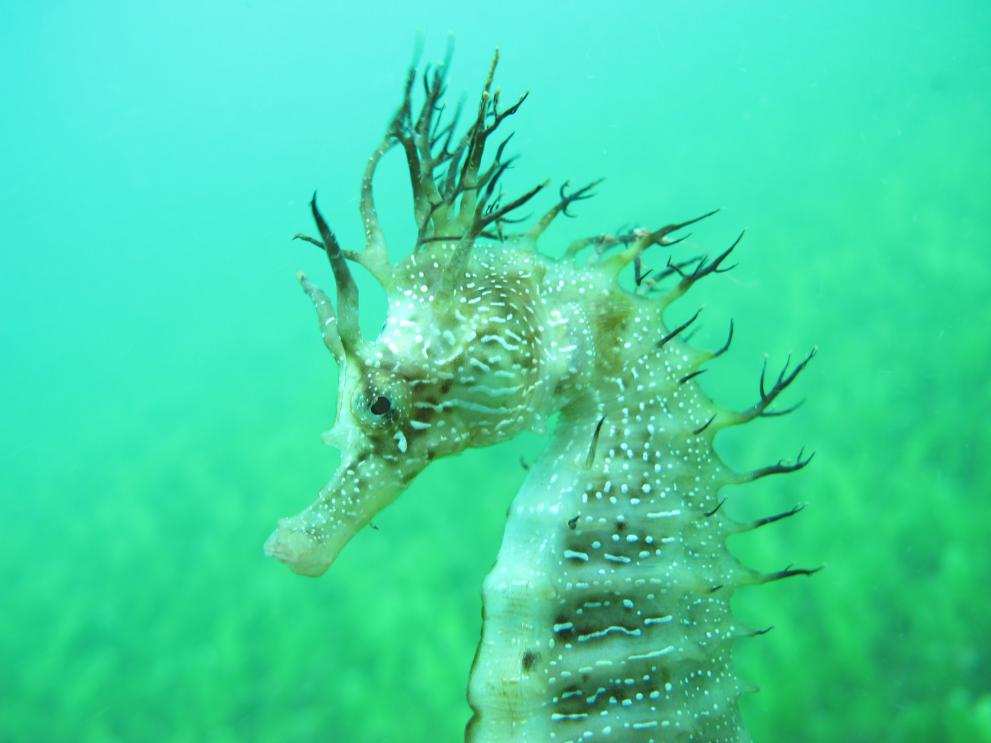
At the start of the century the Ria Formosa lagoon in southern Portugal was home to the biggest seahorse population in the world. Only two decades later, the situation has changed dramatically, and seahorse numbers have fallen by more than 90%. HIPPOSAVE is an action plan for the recovery and conservation of the remaining seahorse populations in the Ria Formosa. The background to the project is a research done by the Resources, Restoration, Connectivity and Climate research group of the Centre of Marine Sciences (CCMAR) of the University of Algarve. For more than a decade this group has focused on the wild seahorse populations in the Ria Formosa and on breeding seahorses in captivity. HIPPOSAVE has been supported by the European Maritime and Fisheries Fund.
The investigation allowed the researchers to learn more about the life history of the seahorses, and their environmental and habitat requirements. It also pinpointed factors that reduce the resilience of this species; these include indirect anthropogenic impacts such as habitat degradation, by-catch in fishing nets, and underwater noise, as well as natural impacts such as silting. Moreover, in recent years, illegal fishing has been directly targeting seahorses.
All those factors had huge consequences, with a sudden decrease in seahorse abundance to less than 90% of the numbers seen just a decade ago. It was and remains urgent to work against all these impacts and thus to safeguard the remaining seahorse populations.
This project had four main aims
- evaluate the current status of the two seahorse species in the Ria Formosa: the long-snouted seahorse (Hippocampus guttulatus) and the short-snouted seahorse (H. hippocampus)
- monitor the conservation relevance of two recently created Marine Protected Areas, and at the same time to improve degraded habitats through the combined use of seagrass transplants and artificial holdfasts
- breed seahorses in captivity to be released under controlled conditions in the Marine Protected Areas
- promote 'ocean literacy' among local stakeholders so as to conserve the seahorse populations and safeguard local natural resources in general
At the present stage, the project has successfully monitored the wild seahorse populations, mapped their remaining habitats in the lagoon, and created a small Marine Protected Area (MPA) within the lagoon. Meanwhile, it has developed environmentally-friendly artificial structures to be used for habitat recovery, and deployed them in the MPA, with the result of a significant increase in seahorse abundance, thus providing information for future conservation actions This population has been incremented by restocking from the simultaneous seahorse captive breeding programme, which was successful also thanks to the protected environment within the MPAs.
Eventually, the project has promoted ocean literacy and raised awareness of seahorse conservation. The campaign included lectures to the public and schools, beach cleaning, and information on seahorse biology and conservation made available along some of the lagoon’s pedestrian trails. The seahorse conservation awareness campaign was taken to local schools, where hundreds of young students carried out many activities relating to seahorse biology and conservation.
The project also resulted in a collaboration with schools in France, thanks to the work of Camões IP, a public institution that promotes Portuguese language and culture. A project entitled 'Les amis de l’hippocampe et la biodiversité marine' reached more than 4000 young students in France.
The EU funding made a vital difference in the study and implementation of conservation actions for the protection of these species, both immediately and in the near future. Seahorses are flagship species whose sensitivity is fully representative of their environment. They are good indicators of ecosystem quality. Seahorse conservation actions can therefore be extended to their habitat and to the overall ecosystem, thus benefiting local biodiversity. In turn, improvements in local biodiversity directly benefit the area and those who use it either professionally or for leisure.
More information
Details
- Publication date
- 21 December 2022
- Author
- Directorate-General for Maritime Affairs and Fisheries




